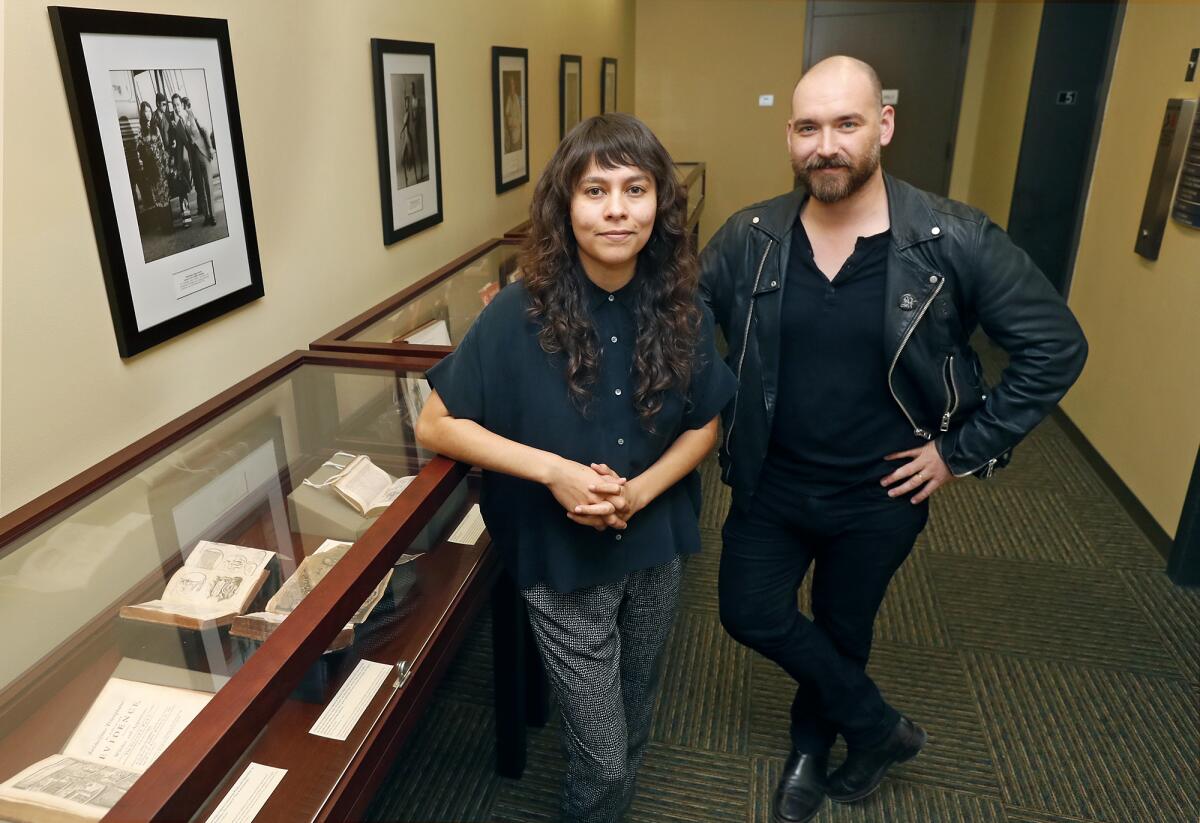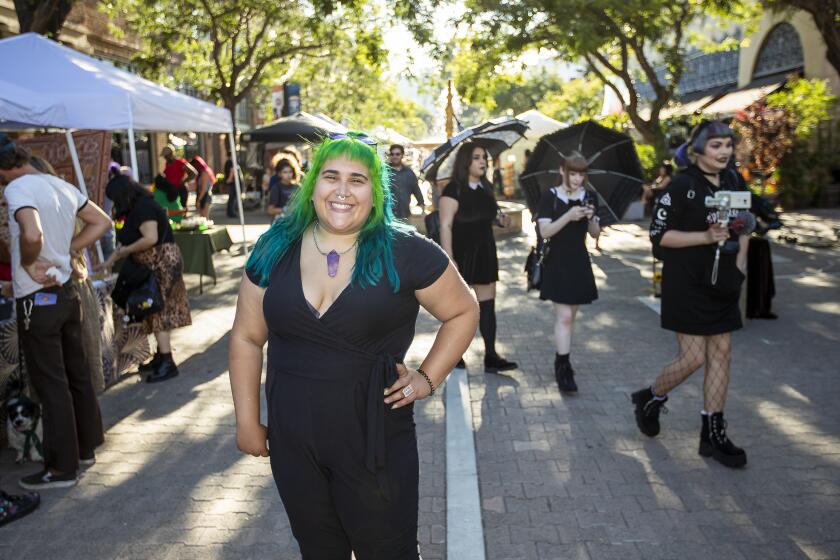Double, double toil and trouble — a new exhibit on witchcraft opens at UC Irvine

- Share via
Sorcery and bubbling cauldrons are known as calling cards of witches. But as it turns out, they aren’t requirements to be one.
A new exhibit on witchcraft and its rise as a feminist identity is opening to the public Friday at the Langson Library at UC Irvine. “We Are the Witches You Couldn’t Burn” tracks the history and evolution of witchcraft between the 16th and 21st centuries.
The exhibit will be on the fifth floor of the library through early December. The materials are largely from the university’s collection, but many older pieces were donated.
“The history of witches and witchcraft is ... a really beautiful history. You go from persecution to liberation and empowerment,” said Elvia Arroyo-Ramirez, assistant university archivist.
“The archetype of the witch has always been this presence that has just been meant to be bad,” she said. “But now I think this generation has really taken it all the way around and been like ‘You know what? I’m going to practice witchcraft and it’s going to be a positive, intentional thing,’ and there’s no shame.”
Derek Quezada, outreach and public services librarian for UCI, said inspiration for the exhibit came out of work he was doing with a group of art history students to practice curation based on avant-garde Russian art.
A student reached out to Quezada afterward, asking to curate an exhibit.
The team eventually decided on feminism and witchcraft.
Quezada said timing the witchcraft exhibit around Halloween was coincidental. It was originally intended to be completed in the summer, but the student went abroad, he said.
“This was a subject that I’m really surprised we have a lot of material in our collections, and myself and Elvia both have a personal interest in the occult and witchcraft. So we decided to just do it together on our own,” he said.

The oldest piece in the collection, a book in Latin called “Tractatus de confessionibus maleficorum et sagarum. An & quanta fides ijs adhibenda sit?” dates to 1623 but was originally published in 1589.
It discusses confessions obtained by witch hunters, claiming that those gained under torture were valid.
Another book, “Sadducismus Triumphatus” from 1726, expresses a belief in the existence of witches and attacks those skeptical of that.
“Sadducismus Triumphatus” — translated as “A Full and Plain Evidence Concerning Witches and Apparitions. In Two Parts. The First Treating of Their Possibility. The Second of Their Real Existence” — influenced the beliefs of Cotton Mather, who was instrumental in the Salem witch trials in Massachusetts.
The trials, from 1692 to 1693, saw the executions of 19 people.

Each of the four display cases in the exhibit highlights a different time in witchcraft, curators said.
Witchcraft is having a bit of a moment in contemporary culture, with many working witches seeing themselves as healers. Other new-age beliefs such as tarot card readings, crystals and astrology have incarnations in witchcraft, curators said.
“All of that really started with early witches. It’s just permeated into contemporary culture. We just accept it. It was a witch doing [astrology] back in the day,” Quezada said. “We live with a lot of the elements of witchcraft, whether we realize it or not.”
Orange County is no stranger to contemporary witchcraft, given that Santa Ana is the site of Witch Walk DTSA.
For Lacey Conine and her coven, the common image of witches wearing cloaks and practicing rituals in the woods is inaccurate.
Lacey Conine, founder of Witch Walk DTSA and a witch herself, said becoming a witch was an act of liberation.
“Witchcraft has always been, for the most part, a war on womxn, as womxn are the main ‘gender’ associated with the craft,” she said in an email. “However, men have always practiced witchcraft too. We know it isn’t about ‘men’ or ‘womxn.’ Nonbinary and gender-fluid witches exist too.”
Conine described the issue as a “war” on people expressing control of their healing, spirituality and health.
Witchcraft has changed in the past few years because of its rising popularity on social media, she added.
“It’s entrepreneurs and young people and black, indigenous, people of color trying to reconnect to what has been taken away from them. It’s liberation. It’s coming home,” she said.
“Instead of blanketing spirituality with statements of ‘oneness,’ witchcraft unpacks the intersections of individual experience and allows them the agency to take back their power and stand in it.”
IF YOU GO
What: “We Are the Witches You Couldn’t Burn: Women and Witchcraft Through the Ages”
When: Friday through Dec. 9; 8 a.m. through 5 p.m. Mondays through Fridays
Where: Langson Library, fifth floor, UC Irvine
Cost: Free. Visitor parking is $13 in the Student Center parking structure at Campus Drive and West Peltason Drive.
Information: (949) 824-6842
All the latest on Orange County from Orange County.
Get our free TimesOC newsletter.
You may occasionally receive promotional content from the Daily Pilot.





